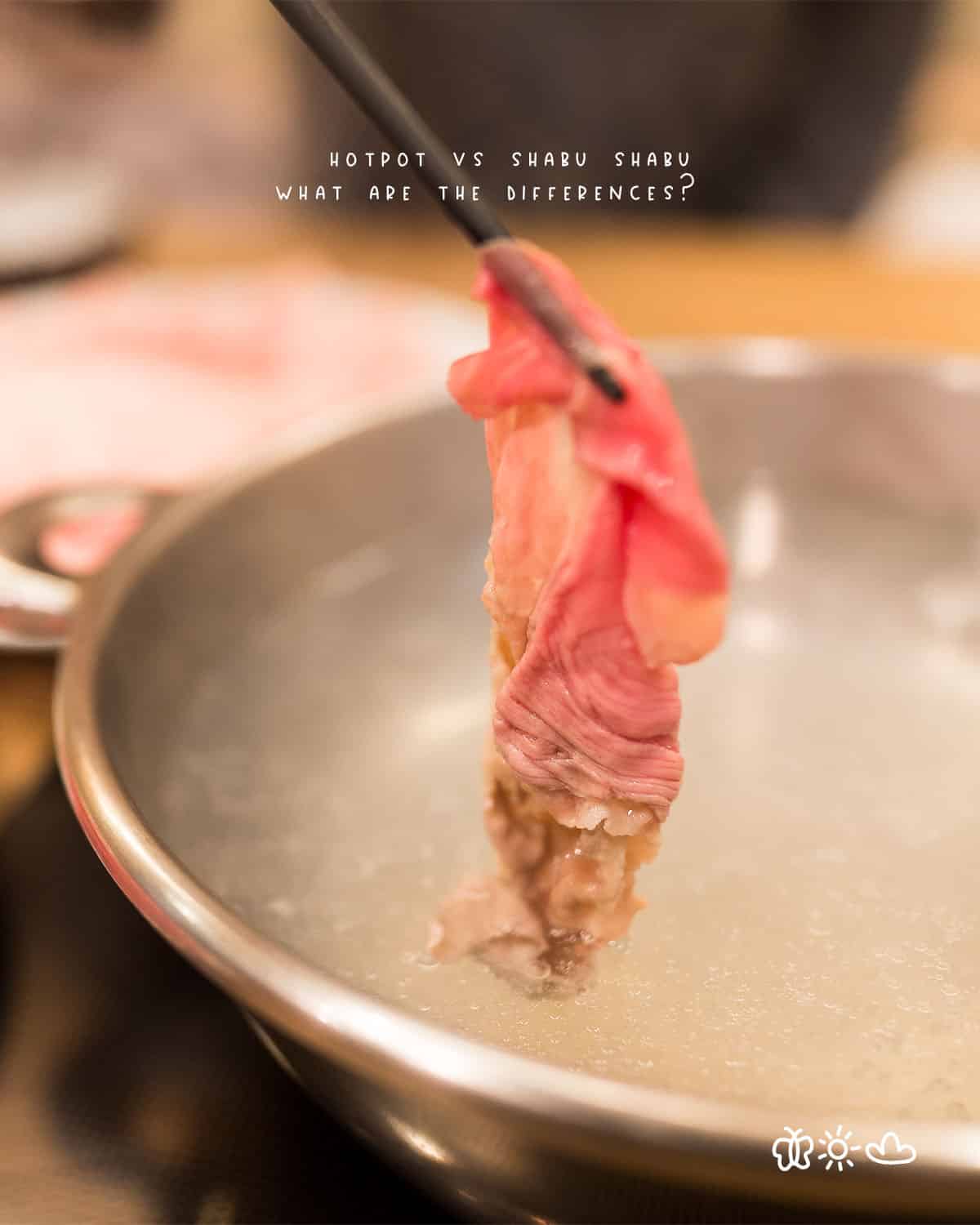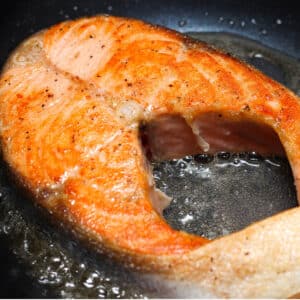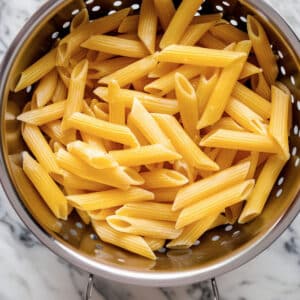There are many different types of Asian cuisine; two of the most popular are hot pot vs shabu shabu. While they share some similarities, there are also some major differences between these two dishes. In this post, let's delve deeper into those differences to decide which is right for you.
When it comes to Chinese hot pot and Japanese shabu shabu, there are some key differences. Both involve cooking meat and vegetables in a broth at the table, but the ingredients and cooking methods vary. Let's take a closer look at these two popular Asian dishes.

Hot pot vs shabu shabu
You can throw all your meat into a hot pot to chillax a la you in a bubbling cauldron of deliciousness, OR you can pick and choose your slices with surgical-like precision in shabu-shabu.
| Differences | Shabu Shabu | Hot pot |
|---|---|---|
| Broth | uses light broth | uses heavier broth (spicy or mild) |
| Type of meat | thinly sliced meat | thinly sliced meat or thick sliced |
| Vegetables | use a wider variety of vegetables | sticks to a few basic vegetables |
| Dipping sauce | traditional dipping sauce: 1. goma dare 2. ponzu sauce | most popular sauces: 1. Sacha dipping sauce 2.garlic sesame sauce 3. spicy garlic hot sauce |
| Cooking method | swishing thinly sliced meat into boiling broth | place the ingredients in boiling broth until cooked. |
| Noodles | clear noodles | thick noodles |
In a hot pot, there is no discrimination. All are welcome to the party--the chicken, the beef, the shrimp. No one is left out. It's an all-you-can-eat buffet where the bold and spicy mingle with the more mild and delicate. It's a true melting pot (pun intended) of flavors and textures, where the sum is greater than its parts.
Shabu shabu (しゃぶしゃぶ), on the other hand, is a bit more refined. It's all about quality over quantity. You carefully select the choicest cuts of meat and then cook them to perfection in a clean, clear broth. Each bite is an exquisite experience, and you savor every last one.
Those who like natural flavors, rare or medium-rare meat, simple sauces, and a variety of vegetables may prefer shabu-shabu over a hot pot. So if you fall into that category, welcome to Shabu Shabu.
So which is better? That, my friends, is a matter of personal preference. But we can say this: hot pot is the perfect meal for large groups, while shabu-shabu is ideal for more intimate gatherings. So choose accordingly and enjoy!
What is shabu shabu?
Shabu-shabu (Chinese: 汁焼鍋; pinyin: zhī yān guō) literally means "swish-swish hot pot." It's a Japanese dish of thinly sliced meat (usually beef) and vegetables cooked in a broth. The vast majority of things in Japan have come from China, which explains why shabu-shabu actually has a Chinese name.
It is a Japanese dish that typically features thinly sliced meat cooked in a broth with vegetables. The dish's name comes from the sound made when the meat is cooked in the broth. On the other hand, hot pot is a Chinese dish that features meats and vegetables cooked in a simmering pot of broth.
In the same way, Chinese Xiaolongbao is distinct from Japanese Gyoza; hot pot is also quite different from shabu-shabu. Though both are popular Asian dishes that typically involve cooking meat and vegetables in a broth, the similarities pretty much end there. Despite their differences, they are both great in their own right.
What is a Chinese hot pot?
Hot pot [火鍋; pinyin: huǒguō; literal meaning "fire pot"] is a Chinese cooking method traditionally used for simmering meats and vegetables in a broth placed in the center of the table. Everyone around the table can choose their own ingredients to cook in the broth. Some popular hot pot ingredients include thinly sliced meats, vegetables, noodles, and dumplings.
The hot pot is also known as a Chinese steamboat. The term "steamboat" refers to the original cooking method for hot pot. Cooking hot pot in ancient times involved placing a pot of boiling water in the middle of the table. Then, people would use bamboo steamers for cooking food in hot water.
Nowadays, hot pot is typically cooked on a gas or electric stove, making it more convenient (and less dangerous) to prepare.
How is shabu-shabu different from hot pot?
There are a few big differences between hot pot and shabu shabu, the two most popular Japanese-style fondue dishes. One difference is that shabu shabu uses much thinner slices of meat. This means the cooking time is significantly shorter – just a few seconds per slice! – and results in a more delicate flavor.
Here are the key differences between hot pot vs shabu shabu
1 Broth
For one, shabu shabu is cooked with a light broth, whereas hot pot uses a heavier broth. The lighter broth in shabu shabu emphasizes the natural flavors of the meats and vegetables, unlike hot pot, where the heavier soup serves as a meal in itself.
In shabu shabu, you cook the meat and vegetables in the broth for a short period before eating. Compared to hot pots, the meat and vegetables have less intense flavors.
On the other hand, hot pot soup requires a longer cooking time than regular soup. By doing this, the flavors of the soup can penetrate the meat and vegetables, making them more flavorful.
2 Types of meat
Another big difference between hot pot vs shabu shabu is the type of meats used. In general, shabu shabu uses thinly sliced meats, while hot pot uses thicker cuts of meat.
As a result, thinly sliced meat cooks faster than thicker cuts. Therefore, there is a significant reduction in cooking time – just a few seconds per slice! – and results in a more delicate flavor without overcooking it.
Hot pot, on the other hand, is often cooked for a while. This allows the thicker cuts of meat to cook through and become more tender. The longer cooking time also allows the flavors of the soup to seep into the meat, making it more flavorful.
3 Vegetables
Shabu shabu also typically uses a wider variety of vegetables than hot pot. While both dishes usually include leafy greens and mushrooms, shabu shabu will often include vegetables like carrots, onions, and celery.
However, a hot pot usually sticks to a few basic vegetables. This is because the longer cooking time can cause delicate vegetables to lose their flavor.
4 Dipping sauce
The dipping sauce is probably the most crucial part of any hot pot or shabu shabu meal – it can make or break the dish. Why? Because the dipping sauce is what gives the meat and vegetables their flavor. Without a good dipping sauce, your hot pot or shabu shabu will be bland or boring.
There are many different types of dipping sauces out there, but there are two traditional sauces that are popular for shabu shabu:
1 Goma Dare or sesame sauce
There are a few different ingredients in this roasted sesame sauce, like soy sauce, rice vinegar, sugar, and ground sesame seeds (tahini). It has a nutty flavor and a slightly thick consistency.
My favorite brand is the Goma tare sesame sauce from amazon because it is nutty and has a slightly sweet taste. I also like the thickness of the sauce, which makes it perfect for dipping meat and vegetables.
2 Ponzu sauce
Ponzu is a citrus-based sauce made with ingredients like soy sauce, rice vinegar, mirin, and citrus juice like yuzu or lemon. It is commonly used as a dipping sauce for shabu shabu or as a dressing for salads and other dishes. Ponzu has a tart and tangy flavor that is slightly acidic.
What does ponzu sauce taste like?
The taste of ponzu sauce is tart and acidic. It is made with citrus fruits, such as lemons, limes, and vinegar. Soy sauce, mirin (a type of rice wine), and dashi (a fish stock) are common ingredients. Keep in mind that there are several types of ponzu sauce, from lemon to yuzu, so the exact taste will vary.
In addition to sesame paste, chili oil, and soybean paste, there are other popular hot pot sauces.
So, what are the most common dipping sauces for Chinese hot pot?
1 Spicy garlic hot sauce:
Ingredients:
- 1.5 tablespoon of black vinegar
- 1.5 tablespoon of oyster sauce
- 1 tablespoon of minced garlic
- ½ – 1 tablespoon of Red Chili (chopped)
- ⅓ teaspoon of Korean red chili flakes
- 1 tablespoon of green onion
- ¼ teaspoon of grounded Sichuan Pepper
- ½ tablespoon of sesame seeds
- 2 tablespoon of hot oil
- Cilantro
This spicy garlic hot sauce is great for both hot pot and shabu shabu. It has the perfect balance of spice, sweetness, and savoriness that can go well with anything. It's sweet because of the black vinegar and oyster sauce. It's spicy because of the chili flakes and Sichuan pepper. The garlic, green onion, and sesame seeds are savory.
The best part about this sauce is that it's effortless to make. Simply mix all the ingredients, and you're done! Making it is simple, and it keeps for a week in the fridge.
2 Creamy Garlic Sesame Sauce
Ingredients:
- 1 ½ tablespoon of sesame paste
- 1 tablespoon of Minced Garlic
- 1 teaspoon of dashi powder
- 2.5 tablespoon of black vinegar
- 2 tablespoon of hot water
- Sesame seeds
- Crushed peanuts
- Cilantro
This creamy garlic sesame sauce is my favorite way to enjoy hot pot. It's rich and nutty, with a touch of heat from the garlic. I love the combination of the rich sesame paste with the savory dashi powder and the slight sweetness from the black vinegar. And, of course, the minced garlic and sesame seeds add a great deal of flavor and texture to the dish.
The sesame paste gives the dish a lovely, nutty flavor that is well-balanced by the acidity of the black vinegar. The dashi powder adds a savory umami depth of flavor, while the garlic and sesame seeds provide a nice crunch and heat. Overall, it's a well-rounded and flavorful sauce that I just can't get enough of.
If you're looking for a dipping sauce for your hot pot that is both flavorful and easy to make, look no further than this creamy garlic sesame sauce. It comes together in just minutes and can be easily customization to your taste. So go ahead and give it a try; I promise you won't be disappointed!
3 Taiwanese Sacha dipping sauce
Ingredients:
- 1 tablespoon of minced garlic
- 1 teaspoon of chopped Red Chili (optional)
- 3 tablespoon of Green Onion (chopped)
- 1 ½ tablespoon of Taiwanese Sacha Sauce
- 2 tablespoon of Black Vinegar
This classic Sacha dipping sauce is perfect for enjoying your hot pot or shabu shabu. Soy sauce, chili sauce, and sugar are the main ingredients in Taiwanese Sacha sauce. So, you've got the salty from the soy sauce, the chili's spiciness, and the sugar's sweetness. The combination of Sacha sauce, black vinegar, and chili perfectly balances sweet, sour, and spicy.
This condiment has plenty of flavors and is amazingly easy to make. Simply combine the ingredients in a small bowl and enjoy with your favorite hot pot or shabu shabu dishes.
This Taiwanese chili sauce contains various chilies, garlic, and other spices. It contributes to the characteristic heat and flavor of many Taiwanese dishes. You can find this sauce in most Asian grocery stores.
Black vinegar is a type of vinegar that is made from fermented rice. It has a deep, dark color and a slightly sweet flavor. Black vinegar is commonly used in Chinese cooking and gives dishes a unique flavor. You can find black vinegar in most Asian grocery stores.
5 Cooking method
One of the main differences between shabu shabu vs hot pot is the cooking method. Shabu-shabu is cooked by submerging thinly sliced meat and vegetables into a pot of boiling water or broth, swishing it around a few times (hence the name), then removing it to dip in a sauce before eating.
On the other hand, hot pot involves cooking the ingredients in boiling broth until cooked. This is because the hot pot broth is usually more flavorful than the shabu-shabu broth; thus, the components can absorb more flavor. Additionally, since hot pot takes longer to cook, the meat and vegetables tend to be more tender.
5 Noodles
Another big difference between shabu shabu vs hot pot is the noodles. Shabu shabu is typically served with clear noodles, whereas hot pot typically serves thick noodles.
This is because clear noodles cook more quickly than thicker ones. In other words, you can add them along with the vegetables and meat to the pot simultaneously.
Thicker noodles, on the other hand, need to be cooked for a longer period. Add them to the pot for best results after cooked meat and vegetables.
How to cook and eat shabu shabu
At shabu shabu restaurants, customers cook their own food in a shared pot of boiling water. This is done by dipping slices of meat and vegetables into the pot for a few seconds, then removing them to eat with dipping sauce. If you're a first-timer, don't worry. The staff will gladly show you how to cook and eat shabu shabu.
The following is a basic guide to cooking and eating shabu shabu:
1 Heat the soup:
The first thing you'll need to do is heat up the soup. This is usually done by placing a metal pot of soup on top of a portable stove. Once the soup is in gentle simmer, it's time to start cooking.
2 Take a slice with your chopstick and swirl the meat around the soup to cook:
After the broth has come to a simmer (but hot enough), add your protein. Take a slice of meat or vegetable with your chopstick and swirl it around in the broth to cook. The key here is not to overcook the food – you want it to be tender and juicy, not dry and tough.
Each person has their own mini-pot of broth to cook their meat in for shabu-shabu. You'll want to add your thinly sliced beef or pork to the pot and then use your chopsticks to swirl the meat around, so it cooks evenly quickly.
3 Dip your cooked food in a sauce:
Once the meat is cooked, you can dip it in various sauces. For example, shabu shabu usually comes with sesame sauce, ponzu (a citrus-based sauce), or soy sauce. Many hot pot restaurants also offer a variety of dipping sauces.
Don't forget to try the different dipping sauces - they can make or break your shabu-shabu experience!
4 Repeat until you're full!
Eat until you're full! That's the best part about hot pot and shabu-shabu – you can keep eating and eating until you're absolutely stuffed. And there's no better way to end a meal than with a satisfied belly.
How to cook other ingredients for shabu-shabu:
When it comes to other vegetables like cabbage and mushrooms, you can cook them in the same pot as your meat. Just add them in when you're about halfway through cooking the meat. Don't put everything at once, though, or the vegetables will overcook. As you eat, add the other ingredients, so everything is perfectly cooked.
If you want to cook noodles for shabu shabu, it's best to do so separately. You can cook them in boiling water or the broth you'll use for your shabu shabu. To avoid making a mess, cook the noodles in a separate pot and then add them to your bowl when ready to eat. Doing this allows you to control the cooking time better and avoid overcooking them.
Some scum will bubble to the surface after putting meat in the broth. You can carefully skim the scum off with a ladle or a netted spoon. It's because the hot pot broth is drawing out the impurities in the meat (blood, fat, etc.). The hot pot broth is usually at a rolling boil, so the fat and blood will coagulate and rise to the surface.
How to cook and eat Chinese hot pot?
There are many different ways of cooking hot pot.
- The most common way is to boil the broth in a pot on the stove, add the ingredients and cook them in the broth.
- Other methods include an electric hot pot (tabletop or built-in), slow cooker, and Instant Pot.
If you use a stovetop hot pot, keep the broth simmering on the stove while you cook the ingredients. If you use an electric hot pot, you will already heat the broth to the correct temperature, and you can just add the ingredients to cook.
There are several ways to cook the ingredients. The most common way is to put the ingredients into the hot pot and let them cook until they are done. Cooking meats and vegetables quickly work well with this method.
For ingredients that take longer to cook, such as noodles, you can pre-cook them in boiling water before adding them to the hot pot. This will help them cook evenly and prevent them from sticking to the bottom of the pot.
You can eat the ingredients directly from the pot or transfer them to a bowl when the ingredients are finished cooking. If possible, add some broth to your bowl, as it contains flavor and nutrients.
Enjoy your hot pot!
Varieties of Hot Pot (Japanese)
While shabu-shabu is a specific type of hot pot, there are wide different varieties of hot pot. Hot pot can vary greatly depending on the region, ingredients, and seasonings.
Here are a few of the most popular types of hot pot:
1 Mizutaki:
This hot pot originates from Kyushu in southern Japan. The broth is typically made with chicken and vegetables, and the dish is often served with dumplings.
2 Shabu-shabu:
As mentioned, shabu-shabu is a specific type of hot pot. It typically features thinly sliced meat cooked in a broth and then dipped in various sauces.
3 Sukiyaki:
Sukiyaki is another popular type of hot pot. The dish is made with thinly sliced beef cooked in a sweet soy sauce-based broth. The dish is usually served with noodles and vegetables.
4 Chankonabe:
Chankonabe is a hot pot dish that sumo wrestlers often eat. It is made with various types of meat and vegetables and is typically served with rice.
5 Nabe:
Nabe is a general term for hot pot. You can make it with any combination of meats, vegetables, and noodles.




